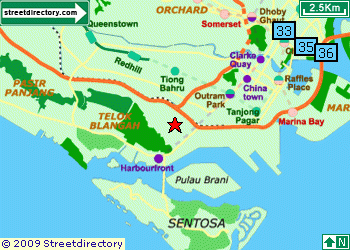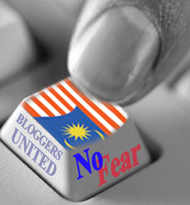
Johor State Emblem
Temasek, then Singapura and now Republic of Singapore have had very close ties with Johor. A lot of these heritage buildings and properties are still available for public visitation and functional, long after British rule and Singapore achieving its own Independence.
Excerpt from an article written by NST senior writter Fauziah Ismail:
SPIRITUAL SITE: Masjid Temenggong Daeng Ibrahim Johor Darul Takzim is the mosque next to Temenggong Abdul Rahman’s first residence in Teluk Belanga.
I have read and written about Teluk Belanga for this column but I don’t know where in Singapore it exactly is.
Datuk Abdul Rahim Ramli, the secretary of the Johor Council of Royal Court and Chancellor of the Most Honourable Order of the Crown of Johor, provided me the answer in one of his emails on the state.
“Telok Belanga covered an area of about 80.94 hectares on what is now called Mount Faber,” he wrote.
Teluk Belanga, Temasek
In fact, I read that Mount Faber was originally known as Telok Blangah Hill but was later renamed after Captain Charles Edward Faber of the Madras Engineers, the superintendent engineer in the Straits (and brother-in-law of Governor Major-General William John Butterworth), who arrived in Singapore in September 1844.
It was Sir Stamford Raffles who persuaded the Temenggong to move to Teluk Belanga after Arab trader Syed Yassin who stabbed Singapore’s first resident Major-General William Farquhar was found hiding in the settlement.
Raffles had also provided compensation for the construction of houses for the Temenggong and his followers.
“The buildings then were not pretentious,” Rahim wrote. “The residence for Temenggong Abdul Rahman and his family could hardly be known as a palace of modern days. This building was situated in an area known as Bukit Tanjong Aur. A mosque, octagonal in shape, was built and was also used as a Balai Rong Seri (Audience Hall).”
According to Rahim, the land was on lease from the East India Company with a proviso that if the Temenggong, his heirs or successors should prefer to move from Singapore and reside permanently in Johor, the company will pay him 15,000 Spanish dollars. In return, the Temenggong and his successors should relinquish all rights and title to all his immovable properties including land and buildings there.
However, it was his grandson, Sultan Abu Bakar who successfully negotiated with the English for a permanent title of Telok Belanga on Aug 15, 1864. This land was one of the territories of Johor where the Johor flag was flown.
Sultan Abu Bakar built a palace on 17.5ha of land at Bidadari Estate in the Serangoon district of Singapore for his consort Enche’ Puan Besar Zubaidah. The palace was known as Istana Bidadari (The Singapore government subsequently acquired the land in 1904 and turned it into Bidadari Cemetery for Muslims, Hindus, Singhalese, and Christians of different denominations).
It was sometime in 1860 that Sultan Abu Bakar purchased a landed property once owned by his legal adviser William Napier that was advertised for sale in March 1857 by Boustead and Co.
The house called Tyersall stood on 26ha of land in the Tanglin area in Singapore.
The house was demolished in 1890 and both Sultan Abu Bakar and his consort Sultanah Fatimah planned a new building, which had been described back then as “one of the grandest homes built in the Victorian Eclectic idiom, combining not only gothic and classical motifs, but also some Indo-Saracenic elements into the design”.
The building was rectangular in shape with a central courtyard, a red-tiled roof and a tower nearly 21.3 metre high, was topped by a symbolic star and crescent.
Its architect was Datuk Yahaya Awaludin, who drew up the plans according to the wishes of Sultanah Fatimah. Yahya was the chief engineer in Abu Bakar’s Cabinet.
The building was completed in 1892, a year after Sultanah Fatimah’s death.
Sultan Abu Bakar named the palace “Istana Tyersall” and made it his official residence. Tyersall was described as “a lavishly appointed palace whose splendour made a great occasion.
“It was adorned with Chinese and Japanese curios collected by Sultan Abu Bakar on his travels. It was officially reopened on Dec 3, 1892 by Governor Sir Cecil Clementi at a ball attended among others by the rulers of Pahang and Riau and leading lights of Singapore and Johor society,” Rahim said
On April 4, 1895, Sultan Abu Bakar executed a will expressing his intention for Tyersall to become state property after his death for the use and enjoyment of his heir and successors.
View of the Royal Mausoleum from the cemetery in the grounds of Masjid Temenggong Daing Ibrahim Complex
Tyersall was destroyed in a fire, caused by faulty electrical wiring, on the morning of Sept 10, 1905. Part of its grounds excluding the building was acquired by the Singapore government in November 1990 under its Land Acquisition Act.
In the same will, Sultan Abu Bakar had bequeathed a house called Woodneuk and the surrounding gardens spreading across 12.14ha at Tanglin Singapore (adjacent to Tyersall) to Sultanah Khatijah.
The whole Masjid Temenggong Daing Ibrahim Complex. The green-roofed building on the left is the main mosque. The one on the right is the Royal Mausoleum. Not seen in the complex is the residential units of all the mosque officials incl the imam
Sultan Ibrahim bought the property from Sultanah Khatijah before she died. In 1930, the sultan and Sultanah Helen rebuilt Woodneuk into another magnificent palace.
Woodneuk, according to Rahim, was often mistaken for Tyersall because of its proximity. “The difference was that Woodneuk had a blue tiled roof,” he explained.
The palace and its grounds is now the private property of the current ruler, Sultan Iskandar.
Meanwhile, the mosque next to the Temenggong Abdul Rahman’s first residence in Teluk Belanga, is known as Masjid Temenggong Daeng Ibrahim Johor Darul Takzim. According to the Singapore Islamic Religious Council, the mosque is managed by the Johor government.
Adjacent to the mosque is the Makam Temenggong, where Temenggong Abdul Rahman and his son, Temenggong Ibrahim, are buried.
The mausoleum is the final resting ground of 34 other members of the royal family including Sultanah Khatijah, a consort of Sultan Abu Bakar (son of Temenggong Ibrahim and grandson of Temenggong Abdul Rahman), who died at Istana Woodneuk in Singapore on Feb 1, 1904.
****************
The design and motive of the mosque is exactly like in Masjid Sultan Abu Bakar, Johor Bahru, Masjid Jame’ Bandar Maharani, Muar and Masjid Jame’ Batu Pahat.
This is what still the remaining part of the realm of a Johor-Riau Sultanate still being preserved. More over, in a nation where the rulers now are immigrants from a distant land. There are more about private properties belonging to HRH Sultan of Johor, still in the republic. After a long dispute, another major heritage of Tanah Melayu would be surrendered to the government of the day at the end of the month. The descendants of South China who are now the Government of Singapore decided the preserve the building as a heritage building.
We shall save that for another time.
















*Comments deleted
Please respect this posting is about heritage and history
Vinnan,
I don’t see a point to argue this case with a less educated and ill-mannered person.
Have a nice day.
Jimmy Hillhead
This is like going down memory lane.
I use to grow up here. 🙂
The graveyard were the place we played hide and seek. Visiting kids were to afraid to search us hiding amongst the graves.
The short cut to Mount Faber was via a side fense.
BTW Biggie, since when did you allowed that banned commentator vinnan?
Delighted to read this article on the architectural heritage of Temasek, now Singapore.
Well done, Big Dog!
Read Kilat Senja by Dr Hadijah Rahmat for more stories on Telok Blangah and demise of the kampongs in Singapore.
This was an interesting piece and I did learn some historical facts that I was not aware of before.
It is also a nice respite from the usual “heavy” political pieces, so, in that way, it was appreciated as well.
On the same day that you made the posting, OutSyed the Box had this piece to offer. I found it very interesting since the writer does not mince his words and he calls a spade a spade. It’s an eye opener and I wanted to share it with you and the other readers of your blog. The writer has the interests of the Malay population at heart, and he highlights how the present diesel pricing scenario will be felt by the Malay population.
http://syedsoutsidethebox.blogspot.com/2011/06/libya-and-price-of-fish.html
We know that these properties were not included in the “Points of Agreement” negotiated between Daim Zainuddin and Lee Kuan Yew.
It’s a pity that the Malaysian government didn’t try harder to hang on to the Tanjong Pagar railway station in Singapore, instead of agreeing to move KTM’s operations to Woodlands. Tanjong Pagar is a strategic part of the 2nd downtown planned by the Singapore government around the Marina Bay/Shenton Way/Tanjong Pagar area, with land values expected to increase very substantially.
Rocky,
Just to share with you some shocking story about a mega-project in South Johor that went down the drain. More to come?
Published June 15, 2011
CIMB puts Asia Petroleum Hub under receivership
The firm, mandated by govt to develop an oil terminal, was given RM1.4b loan
By S JAYASANKARAN
IN KUALA LUMPUR
ASIA Petroleum Hub (APH), a private company mandated by Kuala Lumpur to develop and operate a multibillion-dollar oil terminal in Johor (Iskandar Malaysia), has been placed under receivership by CIMB Bank.
This could bring a grim end to a development once billed as one of the world’s largest fully integrated terminals with storage capacity of 924,000 cubic metres, large transhipment capacity and multiple jetties – all located on a 40 ha reclaimed island off the coast of Johor.
At full capacity it could generate up to US$20 billion in annual revenue, a senior APH official once told the press.
Financial executives familiar with the matter said that in 2006, APH was granted a RM1.4 billion (S$569 million) three-year bridge loan by CIMB.
Out of that amount, APH drew down RM840 million for project costs. Since then, however, the executives said that project costs had escalated and APH was looking for investors for a further RM2 billion in new financing.
Currently, APH is majority-controlled by KIC Oil and Gas, a private terminal operator, while a small (10 per cent) interest is held by Trek Perintis, a private company believed to be linked to the United Malays National Organisation (Umno), Malaysia’s dominant political party which is presided over by Prime Minister Najib Razak.
Even so, there have always been problems with the shareholding structure. More than three years ago, the Cabinet decided that Seaport Terminal, a private company that owns and manages Johor’s Port of Tanjong Pelepas close to the reclaimed island, should be allowed to take up 35 per cent in the project.
Seaport is controlled by Malaysian tycoon Syed Mokhtar Al-Bukhary. The tussle – between Seaport and KIB – over the project has been long-standing but the issue had never been resolved. Indeed, no shareholder agreement between the various parties has ever been inked.
In addition, the ownership of the island, reclaimed by Seaport using government funds, is also unclear. Although APH was allowed by the Ministry of Transport to have site possession, title to the island is still held by the federal government and has never been transferred to APH.
Besides the attendant messiness of some government-related projects, the episode also illustrates CIMB’s hard-nosed attitude towards Malaysian business, even those with influence and connections. At other times, bankers might have been loath to come down on companies with political links.
CIMB is headed by Nazir Razak, an urbane banker who built up CIMB into Malaysia’s second-largest lender in the space of seven years. Mr Nazir is also a younger brother of Prime Minister Najib.
What went wrong with APH isn’t very clear, but the executives said that the firm had to do additional work on the island to shore up its foundations which escalated costs.
The executives said as at end-2010, APH’s cumulative capital expenditure (including capitalised interest) amounted to slightly over RM1.4 billion. But they maintained that 64 per cent of the project’s work had been completed and said they were mystified as to why CIMB had pulled the plug.
CIMB officials could not be immediately contacted for comment but people familiar with the bank said that it had given APH time to repay its debt but the firm could not come up with other investors to help fund the development.
About a month ago, CIMB placed the firm under a receiver, Malaysian accounting firm BBDO-Binder. The agency’s head, Gan Ah Tee, declined comment to BT.
dear author,
i’m interested to know if telok blangah still remains a territory of the crown of johor. the 1864 agreement seems to hv returned telok blangah to Sultan of Johore. You wrote that the johore flag ‘was’ flown there, but to what point in history, may i ask?
thanks.
[…] https://bigdogdotcom.wordpress.com/2011/06/12/johor-pride-and-heritage-in-temasek/ […]